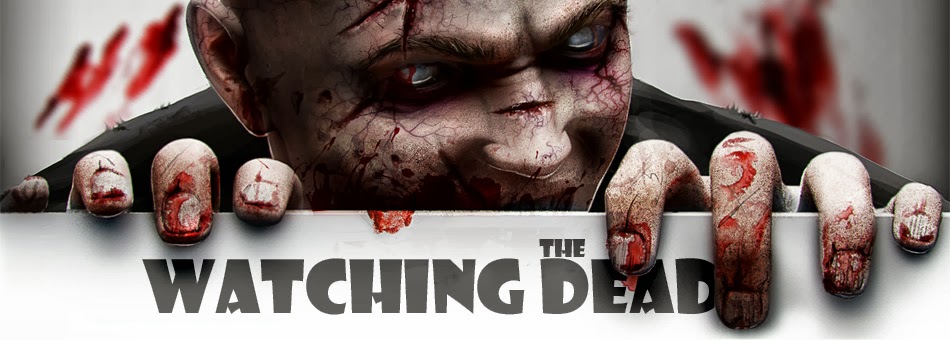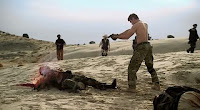
2012 (USA)
2012 Universal
Pictures (Cinema)
Contains
spoilers.
Paranorman is a film
about fear and prejudice; of how a young
boy overcomes the abuse and challenges of being
different to solve an ancient curse, bring peace to the dead and save
the townsfolk from themselves. Whilst marketed as a children's film it's also
definitely not one for the really young with some darker and more complex
themes than you'd get in your average Disney affair.
Young Norman Babcock
(voiced by Kodi Smit-McPhee) has a gift. He can see and speak to the dead;
those souls that are trapped in spiritual form because they have unfinished
business on earth. Because of this gift Norman is misunderstood, feared and
ridiculed by his school mates, his neighbours and even his father and feels
isolated and alone. He mistrusts and shuns genuine attempts at connecting with
him, even the ever persistent chubby school chum Neil Downe (Tucker Albrizzi), and
buries himself at home in his love of horror films and paraphernalia.

300 years ago the
good townsfolk of Blithe Hollow executed an evil witch. Dragged from her mother
and accused of all manner of evil, as she was found guilty and condemned to
death she cast a curse on the judge, the witnesses and the town. The legend of
the witch still dominates the town and it commemorates, celebrates and relishes
in its dark heritage. Or that's what people think. Unbeknown to the town the
curse and the witch are still very much present and are only held in stead by
an annual ritual performed by the witches descendent, and Norman's Uncle Mr
Prenderghast (John Goodman) who also shares the family gift of being able to
talk to the deceased.
Things are coming to
a head though. Uncle Prenderghast fears he is close to his death and feels it's
time to pass on the ritual but dies on the eve of its anniversary leaving young Norman to work it out and save the town all on his own. After a
slow and tense build up Norman suddenly finds himself in the middle of a maelstrom; trying to contain the evil spirit of the witch, flee from the judge and seven
witnesses who have all burst from the grave and keep all this from his family and the town. With hell about to break out though he is joined by his older cheerleading sister Courtney, his school
friend Neil and Neil's older jock brother who all came out to look for him, and
school bully Alvin who tagged along just to beat him up. Between them they have
to come to terms with the fact that there may actually be something to Norman's
gift and also put aside their differences to make sense of what is happening,
find the witches grave and perform the ritual before the curse consumes the
town.
 Evil witches,
curses, ghosts, bullying, mobs with pitchforks, zombies that lose limbs and are shot
and a prevalent mood of mistrust and fear; Paranorman is a dark film full of
dark themes but it's never overly oppressive or sinister. It's behaves like a
classic children's fairy tale, painting scenes that aren't really what they
seem and reducing the horror before it becomes too much. Like Scooby Doo on Zombie Island after introducing the traditional shambling scary looking zombies
and after having an albeit slightly comical but still tense and dramatic chase
we discover the zombies aren't actually the big bad baddies the group perceived
them as being. They're actually full of regret and sorrow for what they did 300 years
ago to the young Agatha Prenderghast
(Jodelle Micah Ferland). They aren't out to massacre the town, they are cursed
to eternal un-life until the small girl they condemned to death can find peace
and they actually want to help Norman achieve this. The zombies really being good, Aggie like Norman and his uncle all being misunderstood, feared and rejected is all part of the
over-arching narrative of acting on assumption and fearing that which one doesn't understand.
Evil witches,
curses, ghosts, bullying, mobs with pitchforks, zombies that lose limbs and are shot
and a prevalent mood of mistrust and fear; Paranorman is a dark film full of
dark themes but it's never overly oppressive or sinister. It's behaves like a
classic children's fairy tale, painting scenes that aren't really what they
seem and reducing the horror before it becomes too much. Like Scooby Doo on Zombie Island after introducing the traditional shambling scary looking zombies
and after having an albeit slightly comical but still tense and dramatic chase
we discover the zombies aren't actually the big bad baddies the group perceived
them as being. They're actually full of regret and sorrow for what they did 300 years
ago to the young Agatha Prenderghast
(Jodelle Micah Ferland). They aren't out to massacre the town, they are cursed
to eternal un-life until the small girl they condemned to death can find peace
and they actually want to help Norman achieve this. The zombies really being good, Aggie like Norman and his uncle all being misunderstood, feared and rejected is all part of the
over-arching narrative of acting on assumption and fearing that which one doesn't understand.
Eventually
everything comes full circle and the citizens of Blithe Hollow see things how
they really are; that with pitch forks and flaming torches ready to burn down
the civic hall that they're more the monsters than the zombies, that Norman
might actually be the hero with a special gift and the they should learn to
tolerate and accept that which they don't understand. It's an old tale done
before but here it's presented in a refreshingly original and vibrant way. With
an emphasis on engaging dialogue the story of retains all the charm of an
animated children's movie, with grittier social commentary and depth for the
adult viewer to chew on.

As for the zombies;
in so much as they're dead and reanimated that's really as far as it goes.
They're not bad, they're not after brains or flesh and they don't really pose a
real threat to anyone. They're reanimated because they're cursed and this curse
only goes so far as to ensure their spirit can't move on and protects them from
being destroyed by being pulled apart, or run over or even being shot, etc.
They're still presented to the traditional zombie spec though, with ripped clothes, groans and
dry dead skin where I did notice a slight blue tinge; a nod to Romero perhaps?
There's also a nod to the comical and absurd side of the genre with many
lighter b-movie moments occurring with and to the zombies. All are brilliantly
executed and never forced, and they provide necessary and expected relief in a
film aimed for the younger audience.
Produced by the
Laika, the same stop-motion animated film team that created Coraline, the film
shares many of the same intelligent and deviant qualities as well meticulous attention to detail, style and artistry and special mention must go to a final twenty minutes, which are as captivating, dramatic and visually exciting as anything I've probably ever seen, animated or not. Paranorman is sharp and witty
with great pacing with a faultless narrative and strong interesting characters.
There's never any dumbing down and the film stays true to its themes and
visions throughout. Directors Sam Fell and Chris Butler have produced a
beautiful and poignant experience and a children's
film with real depth; I can't recommend it enough, 9/10.
Steven@WTD.






































